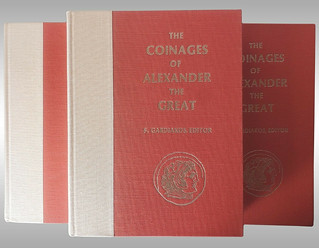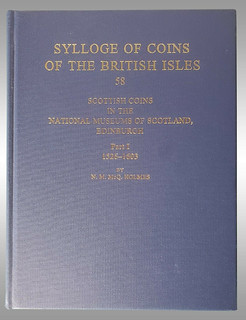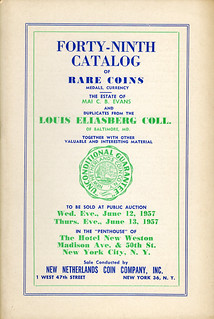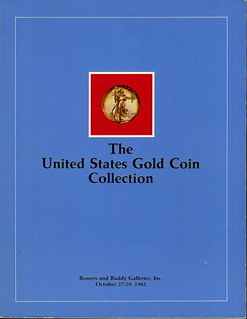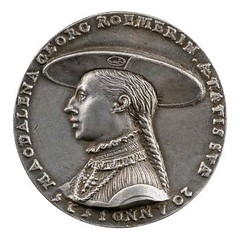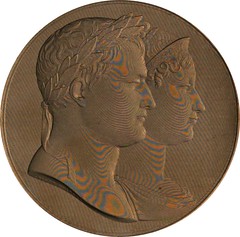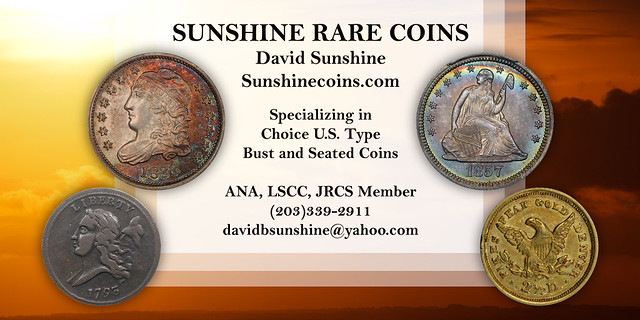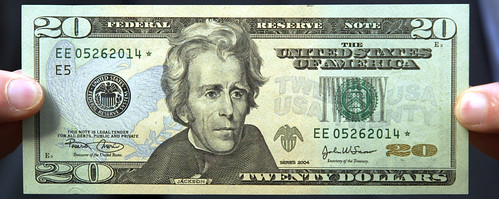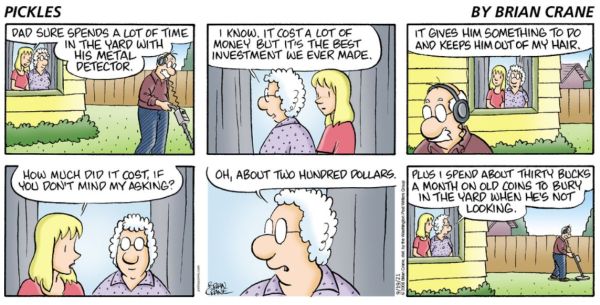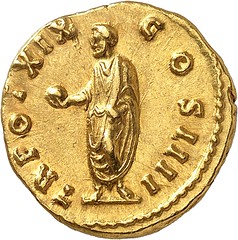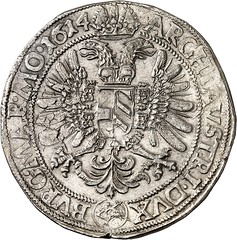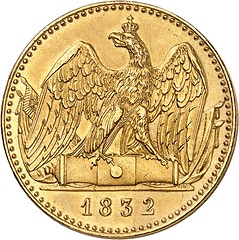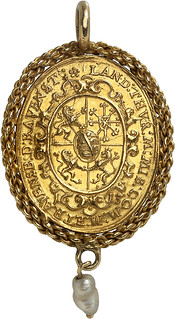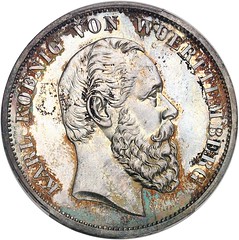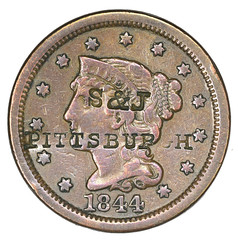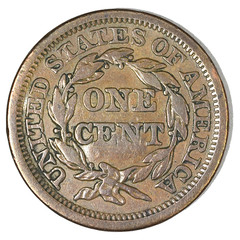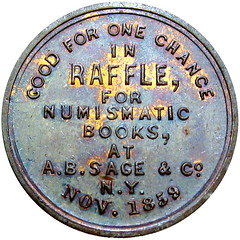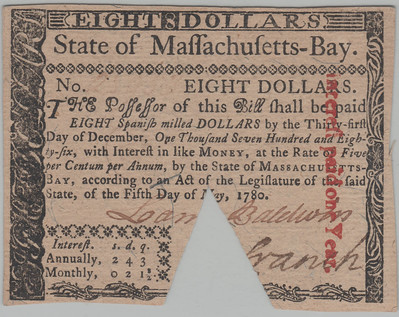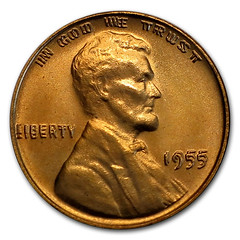
Visit our NBS Sponsors


About UsThe Numismatic Bibliomania Society is a non-profit association devoted to the study and enjoyment of numismatic literature. For more information please see our web site at coinbooks.org SubscriptionsThose wishing to become new E-Sylum subscribers (or wishing to Unsubscribe) can go to the following web page link MembershipThere is a membership application available on the web site Membership Application To join, print the application and return it with your check to the address printed on the application. Print/Digital membership is $40 to addresses in the U.S., and $60 elsewhere. A digital-only membership is available for $25. For those without web access, write to: Charles Heck, Treasurer AsylumFor Asylum mailing address changes and other membership questions, contact Chuck at this email address: treasurer@coinbooks.org SubmissionsTo submit items for publication in The E-Sylum, write to the Editor at this address: whomren@gmail.com BUY THE BOOK BEFORE THE COIN |
- WAYNE'S WORDS: THE E-SYLUM OCTOBER 3, 2021
- NBS BIBLIOTALK PODCAST WITH MARC RICARD
- ANS EBAY LITERATURE SALE OCTOBER 3, 2021
- BRYCE BROWN CATALOG INVENTORY UPDATED
- NEW BOOK: THE HALF CENT HANDBOOK, VOL. 2
- NEW BOOK: WHEN BRITAIN WENT DECIMAL
- PERIODICAL: SCRIPOPHILY AUGUST 2021 ISSUE
- RESOURCE: HERALDRY IN THE SCHER COLLECTION
- JERRY FRANCIS SCHIMMEL (1933-2021)
- NNP: BRAMSEN SERIES ON NAPOLEONIC MEDALS
- VIDEO: ATOCHA TREASURE DIVER CURTIS WHITE
- WHY DO WE HAVE A $20 BILL AND A 25 CENT COIN?
- AMOS NEWSSTAND MAGAZINES
- NOTES FROM E-SYLUM READERS: OCTOBER 3, 2021
- COUNSELING FOR NUMISMATIC SPOUSES
- VOCABULARY TERM: FLEXIBLE MOLD
- PAT MCBRIDE AKA BEN FRANKLIN
- HEIDELBERGER MÜNZHANDLUNG GRÜN AUCTION 83
- NUMISMATIC NUGGETS: OCTOBER 3, 2021
- THE ELUSIVE ELIASBERG 1858-S DIME
- THE QUEEN'S PLATINUM JUBILEE MEDAL
- COLLECTING COLONIAL NOTES BY SIGNERS
- THE ELM CITY BANK OF NEW HAVEN
- TRILLION-DOLLAR COIN SILLY SEASON AGAIN
- HOW THE RARE COIN BUSINESS HAS CHANGED
- FANATICS SHAKES THE SPORTS CARD INDUSTRY
- LOOSE CHANGE: OCTOBER 3, 2021
- MOTION PICTURE MONEY SEIZED IN PHILADELPHIA
- BUYS FAKE BOOZE WITH FAKE MONEY AND DIES
- FEATURED WEB SITE: GROVE MINTING COMPANY
Click here to read the thin version on the web
Click here to subscribe
Click here to access the complete archive
To comment or submit articles, reply to whomren@gmail.com
Content presented in The E-Sylum is not necessarily researched or independently fact-checked, and views expressed do not necessarily represent those of the Numismatic Bibliomania Society.
WAYNE'S WORDS: THE E-SYLUM OCTOBER 3, 2021
 New subscribers this week include:
Amanda Hale,
Geoff Hobson,
James Jameson, and
Tristan Tang.
Welcome aboard! We now have 6,730 subscribers.
New subscribers this week include:
Amanda Hale,
Geoff Hobson,
James Jameson, and
Tristan Tang.
Welcome aboard! We now have 6,730 subscribers.
Thank you for reading The E-Sylum. If you enjoy it, please send me the email addresses of friends you think may enjoy it as well and I'll send them a subscription. Contact me at whomren@gmail.com anytime regarding your subscription, or questions, comments or suggestions about our content.
This week we open with a new NBS podcast, numismatic literature sales, two new books, a new resource on heraldry, updates from the Newman Numismatic Portal, and more.
Other topics this week include Half Cents, Napoleonic medals, the Atocha treasure, Glenda Koppenhaver, Jerry Schimmel, Pat McBride, an auction preview, the Queen's platinum Jubilee, colonial banknotes, counterfeiting around the world, and the Grove Minting Company.
To learn more about the U.S. Mint and Coinage, Britain's "Decimal Day", why we have a $20 bill and a 25-cent coin, the Amos newsstand magazines, the perpetual calendar coin, counseling for numismatist's spouses, flexible molds, a Treaty of Paris medal, Sage's Numismatic Books Raffle, and the wacky trillion-dollar coin idea, read on. Have a great week, everyone!
Wayne Homren
Editor, The E-Sylum
NBS BIBLIOTALK PODCAST WITH MARC RICARD
The latest episode of the Numismatic Bibliomania Society podcast is now available for listening. It's on the NBS web site but also available elsewhere. Vice-President/Secretary Len Augsburger provided this report. -Editor
NBS Podcast Napoleonic Medals, with Marc Charles Ricard
 The latest episode of the NBS Bibliotalk podcast,
The latest episode of the NBS Bibliotalk podcast, Napoleonic Medals, with Marc Charles Ricard,
is now available on the NBS website and other popular podcasting platforms such as Buzzsprout. In this installment, Lianna Spurrier, Bibliotalk producer, interviews Marc Ricard, longtime NBS member and former president. Marc has a broad numismatic library, with one specialty being literature related to Napoleonic medals.
Ricard has a special relationship with these medallic tributes as a descendant of the French engraver Benjamin Duvivier (1730-1819). Duvivier is best known in the American series for the Washington Before Boston medal, while on the other side of the pond he commemorated Napoleon in 1797 with the Treaty of Campoformio medal.
Ricard also has an important collection of Red Books,
a specialty so popular that in 2009 Whitman issued A Guide Book of the Official Red Book as a guide to collecting this foundational reference, launched in 1946 and since issued annually. This is a great opportunity to become more familiar with a few of Marc's books and hear stories regarding the formation of this important library.
Link to Napoleonic Medals, with Marc Charles Ricard
on the NBS podcast page:
https://www.coinbooks.org/resources/podcast.html
ANS EBAY LITERATURE SALE OCTOBER 3, 2021
The American Numismatic Society has an ongoing sale of duplicates on eBay, and numismatic literature is included along with some great coins, tokens and medals. Here's a selection of some current book offerings. -Editor
Used copies of THE COINAGES OF ALEXANDER THE GREAT / NUMISMATIQUE D'ALEXANDRE LE GRAND. Gardiakos, S. Suivie D'Un Appendice Contenant Les Monnaies De Philipe II Et III, Et Accompagnée De Planches Et Tables In Quarto. Some text in French, others in English. Includes several pages of illustrated coin plates. 1981.
To read the complete lot description, see:
Coin Book - The Coinages of Alexander The Great Vol. 1-3 [French Language Books]
(https://www.ebay.com/itm/133889925439)
Used copy of THE COINS OF THE DECAPOLIS AND PROVINCIA ARABIA. Spijkerman, Augustus. Edited With Historical and Geographical Introductions. Includes 84 pages of photographic coin plates. 1978.
To read the complete lot description, see:
Coin Book - The Coins of The Decapolis and Provincia Arabia
(https://www.ebay.com/itm/133889907553)
Used copy of SYLLOGE OF COINS OF THE BRITISH ISLES 58. Holmes, N.M. McQ. Scottish Coins In The National Museums of Scotland, Edinburgh Part I 1526-1603. Includes 99 pages of photographic coin plates. 2006.
To read the complete lot description, see:
Coin Book - Sylloge of Coins of The British Isles 58 (Scottish Coins)
(https://www.ebay.com/itm/133889921389)
Used copy of HANDBUCH DER POLNISCHEN NUMISMATIK. Gumowski, Marian. Includes multiple illustrated coin plates throughout. 1960.
To read the complete lot description, see:
Coin Book - Handbuch Der Polnischen Numismatik / Manual of Polish Numismatics
(https://www.ebay.com/itm/133885739673)
Used copy of EARLY AMERICAN COINS. Vlack, Robert A. A comprehensive listing with valuations of early American coins and tokens used in the American Colonies and early America, prior to the establishment of the United States Mint issue of 1793, including the Washington issues up to 1796. Includes numerous photographic coin plates throughout. 1965.
To read the complete lot description, see:
Coin Book - Early American Coins by Robert A. Vlack
(https://www.ebay.com/itm/133885736973)
Used copy of THE U.S. MINT AND COINAGE. Taxay, Don. An Illustrated History From 1776 To The Present. Includes multiple photographic coin plates throughout. 1966.
To read the complete lot description, see:
Coin Book - The U.S. Mint & Coinage An Illustrated History From 1776 To Present
(https://www.ebay.com/itm/133885738847)
All auction listings are duplicates from the American Numismatic Society and are sold with that pedigree. Founded in 1858, the American Numismatic Society is dedicated to the study and public appreciation of coins, currencies, medals, and related objects. Ever since its foundation, the ANS has assembled a permanent collection, which currently has more than 800,000 objects dating from 2100 B.C. to the present, as well as a numismatic library with approximately 100,000 books, documents, and artifacts. These resources support the publication of books and periodicals, and the hosting of lectures, academic seminars, and exhibitions. Memberships start at $100 and include our quarterly magazine and access to online programs.
NO RESERVE. All auctions are listed without a reserve price. Items are packaged carefully to minimize shifting during transit. Handling time is three (3) business days from payment date, however most lots ship the following business day after payment is made. We will happily combine shipping where possible, please contact us if you would like to combine shipping for lots that end multiple days apart. Buyer should contact the ANS within 30 days upon receiving won lots to request a return; return shipping is the responsibility of the buyer, and the full lot must be returned. Listings are unique and cannot be exchanged.
BRYCE BROWN CATALOG INVENTORY UPDATED
Bryce Brown writes:
"I've updated my pricelist of coin auction catalogs and related numismatic literature on my website http://brycebooks.squarespace.com/
"Please take a look at my new inventory! Also, E-Sylum readers who place a $100 order by October 15th will receive a 15% discount.
"I can be contacted via email at numismatics@att.net or through the website."
NEW BOOK: THE HALF CENT HANDBOOK, VOL. 2
Author Ed Fuhrman shared this information about the second book in his series on U.S. Half Cents. Thanks! -Editor
 I am delighted to announce the launch of my second book "The Half Cent Handbook - Classic Head and Braided Hair Varieties." It is the second in a series of four planned books on U.S. Half Cents. (My first book "Draped Bust Varieties 1800-1808" was released in January).
I am delighted to announce the launch of my second book "The Half Cent Handbook - Classic Head and Braided Hair Varieties." It is the second in a series of four planned books on U.S. Half Cents. (My first book "Draped Bust Varieties 1800-1808" was released in January).
The book contains updated and valuable information on Classic Head & Braided Hair die varieties, die states, grading, attribution, rarity, prices, cherry picking tips, and a whole lot more. Everything is laid out in a clear and concise manner with full color photos. The book is 157 pages, hard cover, full color, smyth sewn binding, and top quality in every way.
This book is a must have for novice and advanced collectors alike. Copies are $100 (shipping included) and are only available directly from the author.
Email:
Guitarman68@optonline.net
Paypal or checks are accepted.
To read the earlier E-Sylum articles, see:
NEW BOOK: THE HALF CENT HANDBOOK
(https://www.coinbooks.org/v24/esylum_v24n08a06.html)
REVIEW: THE HALF CENT HANDBOOK
(https://www.coinbooks.org/v24/esylum_v24n09a07.html)
NEW BOOK: WHEN BRITAIN WENT DECIMAL
We've talked before about Britain's "Decimal Day", when the country switched to decimal coinage over the centuries-old standard of pounds, shillings and pence. A new book by Mark Stocker has been published by SPINK. -Editor
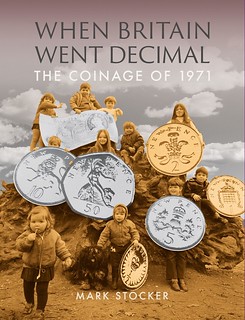 When Britain Went Decimal: The Coinage of 1971
When Britain Went Decimal: The Coinage of 1971
£30.00
Tax included. Shipping calculated at checkout.
ISBN: 81912667567
RRP: £30.00
284mm X 215mm
240pp
Fifty years have now passed since D-Day – the bloodless decimalisation of British currency in 1971. Pounds, shillings and pence, operative for over a millennium, finally yielded to a far simpler system.
The United Kingdom was the last major nation-state in the world to adopt decimal currency, but why was it so slow to do so? What changed politicians' and peoples' minds about it in the 1960s? Were Britain's plans to join the EEC influential? What was the impact of India, South Africa, Australia and New Zealand going decimal several years earlier? Or did it simply happen because of common sense, with a decimal system so much easier to learn?
The route to find the right designs was a complex one, with interfering politicians, struggling artists, and at one stage an angry Duke of Edinburgh! It took over five years to get there, and then there was the seven-sided 50 pence – a design classic we would say today, but what did the media and public think of it when it was launched in 1969?
When Britain Went Decimal takes readers through the changeover leading to D-Day and beyond: how smooth and successful was the process? Did newspapers secretly hope it would fail? While decimalisation might have seemed right at the time, did it lead to inflation, as many people believe today?
Entertainingly written and beautifully illustrated, this first book on decimalisation since 1973 attempts to answer all these questions and more, looking as much at the design – indeed the ‘art' behind the new coinage – as at social, economic and political history.
Author Dr Mark Stocker is an eminent art historian with over 230 publications to his credit, mostly in the areas of public sculpture and numismatics.
For more information, or to order, see:
When Britain Went Decimal: The Coinage of 1971
(https://spinkbooks.com/products/when-britain-went-decimal-the-coinage-of-1971)
"First book on decimalisation since 1973"? SPINK itself published Tom Hockenhull's book Making Change: the Decimalisation of Britain's Currency earlier this year. But no matter - every book matters and brings a diffferent perspective to its topic. Book reviews are always welcome! -Editor
To read the earlier E-Sylum article, see:
FIFTIETH ANNIVERSARY OF DECIMAL DAY IN BRITAIN
(https://www.coinbooks.org/v24/esylum_v24n07a27.html)
NEW BOOK: MAKING CHANGE
(https://www.coinbooks.org/v24/esylum_v24n08a08.html)
PERIODICAL: SCRIPOPHILY AUGUST 2021 ISSUE
The August 2021 issue of Scripophily (number 116) has been published by the International Bond & Share Society (IBSS). Here are the contents. Thanks to Editor Max Hensley for forwarding the information. -Editor
Prodigal Stock Returns
Standard Oil Discovery: £33,750
Bob Greenawalt
Tickers on Stocks
Scripophily Anonymity
Worldwide Auctions
Max Hensley writes:
"The featured article in the August 2021 issue is about the 33,750 BP price for the unique $2.5 million capitalization Standard Oil stock sold by SPINK in its May e-sale. This makes it one of the scripophily kings, and quite a bargain compared to comparable coins and paper money.
"Three issues come with the IBSS membership for $35/yr at http://www.scripophily.org (not .com)."
Max adds:
"I enjoyed that piece about the 1870 20 Yen. Cross-cultural writings and artifacts always have interested me. I was reminded of The Last Samarai movie about the depicted battle and Japan's struggle to remake its society after the opening to the West.
"One area not much appreciated about the Japanese renaissance in the late 1800s is the dispersion of talented Japanese to the West, kind of a reverse transfer. I just wrote an article on one of them, Jokichi Takamine Sr., for the April 2021 Scripophily."
For more information on the International Bond & Share Society, see:
http://www.scripophily.org
To read the earlier E-Sylum article, see:
KüNKER OFFERS 1870 JAPAN 20 YEN
(https://www.coinbooks.org/v24/esylum_v24n38a20.html)
RESOURCE: HERALDRY IN THE SCHER COLLECTION
A new Coin World article by Steve Roach highlights a new online resource for numismatists. -Editor
The Frick Collection has a new online resource for those who are curious about the symbolism of heraldry, illustrated with medals from the Stephen K. and Janie Woo Scher collection of medals.
An introduction by Stephen Scher explains, Heraldry, the system by which coats of arms are designed and used, is a product of the Middle Ages, first appearing during the reign of Charlemagne (768–814 AD)
, adding that it was based on visual clues to help armor-wearing warriors identify one another quickly and accurately on the battlefield.
A glossary provides a full list of heraldic terms and literature on the complex field of heraldry can be found in an extensive bibliography.
The online supplement to recently published book, The Scher Collection of Commemorative Medals, lists those heraldic achievements, or coats of arms, that are found on the medals in the publication, and the numbers by which they are organized correspond to the catalog numbers.
To read the complete Coin World article, see:
New resource on heraldry symbolism opens
(https://www.coinworld.com/news/world-coins/new-resource-on-heraldry-symbolism-opens)
Here's a preview from the site's introduction. -Editor
At some point in their histories, most countries had organizations, often composed of heralds, that controlled the granting and appearance of arms, but except for England and its associated countries—where there are precise rules of design and composition and established laws governing the granting and bearing of arms—such organizations have either disappeared or lost their official authority. In time, individuals were permitted to design and adopt arms with no legitimate claim to authenticity or validity, the sole restraint being that such arms did not copy arms already in existence.
A complete heraldic achievement and its blazon is composed of some combination of the following elements in their proper order: shield, partition, tinctures, ordinaries, subordinaries, charges, crest, helm, torse, mantle, crown, supporters, compartment, insignia, and motto.
To access the Heraldry site, see:
HERALDRY IN THE SCHER COLLECTION OF COMMEMORATIVE MEDALS
(https://www.frick.org/scher_home)
To read the earlier E-Sylum article, see:
NEW BOOK: SCHER COLLECTION OF PORTRAIT MEDALS
(https://www.coinbooks.org/v20/esylum_v20n30a06.html)
THE BOOK BAZARRE
JERRY FRANCIS SCHIMMEL (1933-2021)
John Ostendorf passed along word of the recent passing of author Jerry Schimmel. Sorry to hear this news. This obituary appeared in the September-October 2021 issue of The TAMS Journal, the official publication of the Token and Medal Society. Editor Greg Burns kindly provided the text and John obtained the image for publication here. Thank you. I added some images of his books. -Editor
 Jerry Francis Schimmel
Jerry Francis Schimmel
(May 10, 1933 - August 20, 2021, Pacifica, CA)
Jerry passed away in his sleep after being hospitalized with septicemia following surgeries for which his sister had been caring for him. Jerry was a broadly recognized authority on tokens relating to his city of residence, San Francisco, and wrote a number of award-winning articles on such, some published in the Pacific Coast Numismatic Society's Annual Papers Contest
as well as elsewhere.
Author of U.S. State Issued Sales Tax Tokens in 1973. Author with Michael Pfefferkorn of Chits, Chislers, and Funny Money: A History and Catalogue of United States Sales Tax Tokens, Receipts and Punch-Cards (1977). Author of Chinese American Tokens From the Pacific States (2004) and Chinese American Tokens From the Pacific Coast (2009).
NNP: BRAMSEN SERIES ON NAPOLEONIC MEDALS
The latest addition to the Newman Numismatic Portal is the Bramsen Series on Napoleonic Medals. Project Coordinator Len Augsburger provided the following report. -Editor
Bramsen Series on Napoleonic Medals
Collectors of Napoleonic medals immediately recognize Bramsen
as referring to Ludvig Ernst Bramsen's multi-volume series (Médaillier Napoléon le Grand) on Napoleonic medals published from 1904 to 1913. Bramsen divided the work into three parts, with the first (1799-1809) providing coverage up to the end of the Napoleonic Wars, which represented the peak of the French empire. The second period (1810-1815) covers its subsequent decline, from the ill-fated Russian invasion to the battle of Waterloo. The final installment (1815-1869) includes the Napoleonic exile period and posthumous medallic tributes.
Although not illustrated, the text describes over 2,300 Napoleonic medals and remains the foundational guide for the series. Illustrated here is Bramsen-952, featuring jugate busts of Napoleon and Marie-Louise of Austria, on the occasion of their marriage in 1810 (image courtesy of Marc Ricard), along with a medal-ruled adaptation that appeared in Atkinson's Casket, February 1834.
Link to Bramsen volumes on Napoleonic medals on NNP:
https://nnp.wustl.edu/library/booksbyauthor/544024
VIDEO: ATOCHA TREASURE DIVER CURTIS WHITE
These are selections from the David Lisot Video Library that feature news and personalities from the world of coin collecting. David has been attending coin conventions since 1972 and began videotaping in 1985. The Newman Numismatic Portal now lists all David's videos on their website at:
https://nnp.wustl.edu/library/multimediadetail/522852
Here's one on Atocha Treasure Diver Captain Curtis White. -Editor
Captain Curtis White Recounts Atocha Treasure Find.
VIDEO: 2:59.
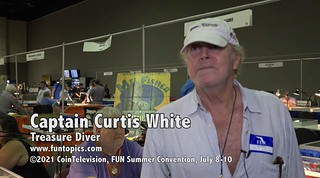 July 9, 2021. Curtis White, Treasure Diver, David Lisot, Interviewer, CoinTelevision.com.
July 9, 2021. Curtis White, Treasure Diver, David Lisot, Interviewer, CoinTelevision.com.
When Mel Fisher discovered the Atocha shipwreck Curtis White was one of his divers. Curtis continued a long career in treasure salvaging many wrecks. He shares the story of the day the Atoche was found and talks about how to be part of the treasure diving experience.
An excerpt of the video is available for viewing on the Coin Television YouTube Channel at:
https://youtu.be/XmSfIPNUNTo
WHY DO WE HAVE A $20 BILL AND A 25 CENT COIN?
OK, so we have a one cent coin and a one dollar bill. We have a five cent coin and a five dollar bill. Likewise, we have a ten cent coin and a ten dollar bill, a fifty cent coin and fifty dollar bill, and a "hundred cent" coin (the dollar) and a hundred dollar bill. A nice mathematical progression. So why the heck do we have a twenty-five cent coin and a twenty dollar bill? Why haven't we ever had a $25 bill?
John Phipps submitted this thoughtful answer. Thank you! -Editor
You asked the question Why do we have a $20 bill and a 25-cent piece, anyway?
That is a question I have heard many times and only got the answer because of the pandemic! Like many, with in-person activities cancelled, I turned to online opportunities.
I learned the answer in a Zoom meeting presented by the Hobby Club in New Delhi, India. The simple answer is our culture. Explaining it is much more complicated. The culture that I am referring to is not high culture like old paintings, the symphony or opera. This culture is created by a blend of tradition, politics, convenience, superstition, religion, science, mathematics, anatomy, language, humor and many more factors. I think of culture as those things that everybody knows but nobody is taught. One example is the expression Women and children first.
We all know it and we all believe it, but it is not taught in school.
First, a look at coins through the lens of our culture. Because of our culture, we think of coins as commodity money. That is to say, coins are worth the value of the metal, or they have intrinsic value. Logically, we know that today this is not true of our coins, but cultural beliefs are very deeply rooted and take many decades to go away if they ever do. Commodity money can be divided or split. The easiest split for the human mind in to divide into halves. So, we have 1/2 dollars, 1/2 dimes and 1/2 cents. Splitting the halves in half again and we have 1/4 dollars. Historically we have split these in half again and gotten pieces-of-eight. We have other fractions of a dollar. One tenth of a dollar is not called a tenth
it is called a dime. One hundredth of a dollar is not called a hundredth
it is called a cent. This is because splitting into 10 or 100 equal pieces is harder for the human mind to consider. So why do we have a 25-cent piece? The answer is culture.
Next a look at banknotes. Our culture has always thought of them as fiat money. That is to say, banknotes are only backed by the good faith
belief in the issuing authority. We do not split fiat money. Almost never have banknotes been torn in half to make lower denominations. It is created for convenience. Convenience in paying with the fewest number of banknotes. Convenience in receiving change in the fewest number of banknotes. Also, the issuing authority wants to print the fewest number of banknotes for lower printing costs and transportation costs. To achieve these advantages of fiat money an efficient scheme needs to be used.
Analyzing various schemes can easily be done empirically. Pick the proposed banknotes in the scheme. Then count the minimum number of notes needed to pay amounts between 1 and 10. The lower the total number, the more efficient the scheme. Here is an analysis of a $1-$2-$3 scheme.
This analysis applies for the issuing $1, $2, and $3 banknotes and issuing $10, $20, and $30 banknotes and issuing $100, $200, and $300 banknotes.
The analysis can be done for any other combination of banknotes that the issuing authority is considering. For a $1-$2.50-$5 scheme the total is very high at 27. So, the $25 banknote is out of the question. I have done this analysis on many schemes. There are two schemes of three banknotes with a total of 19. These are the most efficient schemes, a $1-$2-$5 scheme and a $1-$3-$7 scheme.
So, the final question is which scheme to use, the $1-$2-$5 scheme or the $1-$3-$7 scheme? Culture makes this decision too. With human anatomy, we start counting with one finger, we have two hands and five fingers per hand. The $1-$2-$5 scheme is the obvious winner. And by extension to $10-$20-$50 and $100-$200-$500 if we choose to go that far. Of course, the $2 banknote is not popular because of superstitions in our culture. So why do we have a $20 banknote? The answer is culture.
To read the earlier E-Sylum article, see:
PEARSON: MORE DESIGNS FOR U.S. PAPER MONEY
(https://www.coinbooks.org/v24/esylum_v24n39a14.html)
AMOS NEWSSTAND MAGAZINES
Retired Coin World Editor Beth Deisher kindly submitted these notes in response to my question last week about the Worldwide Coins magazine. Thank you! -Editor
WorldWide Coins was one of four newsstand magazines published by Amos Press Inc. during the first decade of the 21st century.
 The first of the newsstand magazines was Coin Values. Beth Deisher was founding editor and Eric Martin later served as editor. Published monthly, it was launched in December 2003. Coin World subscribers received an edition with a cover different from the newsstand edition, but the interior contents were identical. The magazine featured values of U.S. coins and included feature articles as well as the popular column,
The first of the newsstand magazines was Coin Values. Beth Deisher was founding editor and Eric Martin later served as editor. Published monthly, it was launched in December 2003. Coin World subscribers received an edition with a cover different from the newsstand edition, but the interior contents were identical. The magazine featured values of U.S. coins and included feature articles as well as the popular column, Making the Grade,
later published in book form. Coin Values was published monthly as a stand-alone magazine through February 2011 and was then incorporated into the monthly Coin World magazine.
Paper Money Values, offering values of U.S. federal paper money, premiered with a Winter 2005 issue and was issued quarterly during 2006. During 2007, 2008, and 2009 it was issued bimonthly. Three issues were published as a stand-alone magazine during 2010. Edited by Michele Orzano, content included features about U.S. and world paper money as well as new issues. Editorial content was incorporated into the large monthly Coin World magazine beginning with the June 2010 issue.
 WorldWide Coins was published by bimonthly. Beth Deisher was founding editor and Andrew Perala was managing editor. Features, columns, new issues, and a world coins auction calendar were included in the editorial content. Trends of Mexican, Canadian, and British coins were published in the magazine on a rotating basis. The first issue was published in November 2007. Six issues each were published in 2008 and 2009. The last stand-alone issue was published in January 2010. Beginning with the April 10, 2010, issue the editorial content transitioned as World Coins to the larger Coin World monthly magazine.
WorldWide Coins was published by bimonthly. Beth Deisher was founding editor and Andrew Perala was managing editor. Features, columns, new issues, and a world coins auction calendar were included in the editorial content. Trends of Mexican, Canadian, and British coins were published in the magazine on a rotating basis. The first issue was published in November 2007. Six issues each were published in 2008 and 2009. The last stand-alone issue was published in January 2010. Beginning with the April 10, 2010, issue the editorial content transitioned as World Coins to the larger Coin World monthly magazine.
Presidential Dollars, edited by Beth Deisher, premiered in 2007 as the new series of small dollar coins was issued for circulation. Lack of public acceptance led the U.S. Mint to halt circulation production and to begin marketing Presidential dollars as collector coins. Only one issue of Presidential Dollars (Vol. 1, Issue 1) was ever published.
To read the earlier E-Sylum article, see:
WAYNE'S NUMISMATIC DIARY: SEPTEMBER 26, 2021
(https://www.coinbooks.org/v24/esylum_v24n39a27.html)
NOTES FROM E-SYLUM READERS: OCTOBER 3, 2021
Chocolate 1932 Olympic Medal
Larry Korchnak writes:
"I ran across a small group of 1932 and 1936 Olympic collectibles from the estate of a Nova Scotia athlete. I know that there are collectors of chocolate coins. Perhaps an E-Sylum reader can shed light on this 1932 Olympic chocolate medal so that I can inform the owner."
Interesting. I can't say I've ever seen one of these. I can make out "Rockwood & Co." on the reverse. Can anyone help? -Editor
Glenda Koppenhaver
Regarding last week's list of the Great Ladies of the American Numismatic Association,
Alan Weinberg writes:
"It's Glenda Koppenhaver, not Glenna. I knew her well over almost 50 years. Interestingly, she was in the habit of carrying a small gun in her purse over many years."
A Newman Numismatic Portal search finds many references to her as Glenda (and none as Glenna). Pete agrees: "It appears that Alan is correct." We've corrected the spelling error in our E-Sylum archive, hopefully avoiding any risk of future small-arms fire. -Editor
See also:
PNG Banquet: Salute to Koppenhavers, 7/25/94
(https://nnp.wustl.edu/library/book/578946)
To read the earlier E-Sylum article, see:
THE GRAND AND GREAT LADIES OF THE ANA
(https://www.coinbooks.org/v24/esylum_v24n39a21.html)
 The Centinel Interview
The Centinel Interview
Regarding Gerry Tebben's interview with me in the Fall 2021 issue of The Centinel from the Central States Numismatic Society,
Dave Wnuck writes:
"I just finished reading the interview. Very interesting! I had no idea you have been publishing The E-Sylum for nearly 25 years. Wow! Amazing. You were way ahead of your time.
"And that was a great photo of your desk. At first glance it looks like it could have been taken 75 years ago. "
That's a pre-pandemic photo and the books have been rearranged to put the better ones far from the window light, but only I would notice that. But yeah, except for the computer and monitor it could well be an old-time numismatic library. It's nice to have the books close at hand for consultation.
We're in our 24th volume and will hit that quarter-century milestone September 4, 2022. -Editor
Carol Bastable writes:
"I was also struck by how long you have been editor and also the only editor. It just makes me think of a day that will inevitably come where you will no longer be able to serve (sorry if this is grim). I think of this in my own regard as well with clubs I serve. Key roles that require much time and effort can be impossible to find replacements for. I wonder what the face of clubs will be like in twenty and fifty years from now as there is so much apathy when it comes to willingness to pitch in and serve within so many organizations. Maybe by then there will be so much on the internet that people will Google everything from already existing materials. The foresight of the Newman Numismatic Portal is a big step in that direction.
"I hope you eat a healthy diet and exercise regularly because I would wager that you are indeed irreplaceable. But really, it is amazing that you have undertaken a weekly publication deadline rather than monthly or even biweekly. This means that you have to work at times when you are sick and you have to make plans around this schedule when it comes to travel, family, or whatever. Your dedication has no equal (inaudible applause)."
As it happened, I opened Carol's email while participating in one of my better pandemic-acquired habits - taking a long walk around the perimeter of our neighborhood. Thanks for the good wishes. But that proverbial beer truck could run me over any day, and luckily we have taken some precautions. Just last month our webmaster Bruce Perdue and I walked through our weekly E-Sylum routines for NBS VP Len Augsburger, and our Zoom session was recorded. I've also provided Len with copies of various template files, instructions and account names and login credentials.
It's a part-time job for sure, taking many hours each week and consuming the bulk of my weekend. I have indeed continued working through business trips, family vacations, and bouts of the sniffles. Luckily the work remains interesting and fun, even after all these years.
Our advertisers deserve credit as well - I couldn't devote this amount of effort if it weren't also helping to pay some bills for both my family and NBS. Please patronize and thank our advertisers whenever you have the opportunity.
We recently lost one of our longtime weekly sponsors with the retirement of Fred Weinberg. Fred's irreplaceable of course, but it would be nice to sign up a new or returning advertiser to fill that regular slot. Thoughts, anyone? -Editor
Coins From Returning Servicemen
Regarding a topic in my interview in The Centinel,
Carol Bastable writes:
"I have a theory about the foreign coins (from your Grandfather). I believe many servicemen brought home coins as souvenirs from when they served overseas during war. They could be from places they were stationed or they could have even been shared with soldiers from other countries as allied forces served together. Or maybe not all service men went home immediately after the war and they traveled a bit first. Coins were also engraved as souvenirs both during WWI and WWII.
"Even if your grandfather did not serve, he may have acquired the coins from someone else in the family that did serve. I feel that these foreign coins returning home helped to also fuel coin collecting which became so popular in the 1950's and 1960's with families. Returning servicemen married and started families and when their children were old enough, this was a hobby/collection that could be shared."
Aside from the early crown and 1910 Maundy set, the coins I inherited were very much the pocket change of Europe and could well have been brought home by a member of my grandfather's family. He was actually a step-grandfather, not a blood relative, and I haven't yet traced his history to learn about his military service. -Editor
More on Fred L. Reed, III
David Gladfelter writes:
"I appreciated the memorial to Fred Reed from his family in last week's E-Sylum. It helped me to focus more on what we have gained from his outgoing personality and dogged pursuit of numismatic stories, rather than on lamenting a fruitful career cut short by a debilitating stroke.
 "Fred approached a project as would the captain of a large and diverse team. To fully appreciate his modus operandi, take a look at the lengthy acknowledgments section of his 650+ page book, Civil War Stamp Envelopes, published by BNR Press in 2013. Every person named in this section was recognized for taking part with Fred in a large scale production. I believe this was Fred's final book (eight others preceded it); he was working on a revision when he was felled by the stroke.
"Fred approached a project as would the captain of a large and diverse team. To fully appreciate his modus operandi, take a look at the lengthy acknowledgments section of his 650+ page book, Civil War Stamp Envelopes, published by BNR Press in 2013. Every person named in this section was recognized for taking part with Fred in a large scale production. I believe this was Fred's final book (eight others preceded it); he was working on a revision when he was felled by the stroke.
"Fred was meticulous in his research, thorough in his collection of material, forthright and to the point in his writing style, generous with his time, and honest in giving credit to his sources. I had the pleasure of working with him on projects of both his and of mine.
"I would say of him what he said to me on the title page of one of his books: To a great numismatist & great friend.
"
Agreed - that fits Fred to a "T" -Editor
To read earlier E-Sylum articles, see:
MORE ON FRED L. REED III
(https://www.coinbooks.org/v24/esylum_v24n39a09.html)
NEW BOOK: CIVIL WAR STAMP ENVELOPES
(https://www.coinbooks.org/esylum_v16n35a04.html)
NEW BOOK: CIVIL WAR STAMP ENVELOPES, 2ND PRINTING
(https://www.coinbooks.org/esylum_v16n47a04.html)
Perpetual Calendar Coin
Ken Spindler of
San Diego writes:
"For the turn of the last millennium, I created a numismatic exhibit to teach that even though some Westerners expected our big numeric transition - "Y2K" - to be a harbinger of a major religion-related inflection point for humanity, that wouldn't be the case in the non-Western civilizations that utilize different dating systems (demonstrated by years on their currencies, of course). That interest led to a sub-specialty in the calendar and almanac medals from the French Revolution, from France and neighboring countries, during the years France utilized their revolutionary calendar dating system ("L'an..."), as an adjunct to my abundant other French Rev. numismatic stuff.
"Searching the market for qualifying medals, I've come across quite a few awfully interesting such items from other periods and locales, which have made me regret a bit that I can't afford to simply collect worldwide calendar and almanac medals as a genre unto itself. There must be collectors who do. Take a look at this compelling piece, which I just came across!
"(Interesting that it's in English. The host coin must be Mexico 8 reales 1754-1760, KM-104.)"
Thanks! Very interesting item! -Editor
To read the complete lot description, see:
Perpetual Calendar Made From Genuine Antique 8 Reales 1700's Silver Dollar Coin
(https://www.ebay.com/itm/324804557377)
Spring 1997 JEAS Issue Sought
Jim Contursi writes:
"Does anybody have access to the Spring 1997 issue of The Journal of East Asian Studies, vol. 4, No.1? Supposedly, it contains an article I'm seeking, entitled "The Coins of Shanghai" by A.M.T. Woodward, a scan of which would be greatly appreciated."
The current JEAN site is https://issuu.com/jeandigitala1/, but this incarnation of the journal only goes back to 2017. -Editor
The Pickles Metal Detector
Nick Graver passed along the Pickles cartoon from September 19, 2021. Thanks. -Editor
Years ago my grandmother enjoyed passing the time helping my sister make arts and crafts items that she would sell at craft shows. What she didn't know was that sis couldn't sell them as fast as grandma could make them - at night her and my Mom would take the things apart and put the beads and other parts back into the bins. -Editor
To read the cartoon online, see:
Pickles by Brian Crane for September 19, 2021
(https://www.gocomics.com/pickles/2021/09/19)
COUNSELING FOR NUMISMATIC SPOUSES
This article about building a happy marriage uses a great numismatic example that may hit home for many of us collectors. -Editor
 Dr. John Brown, a Notre Dame history professor, is in the process of moving into a new office. After removing stacks of papers from his closet, he spied a penny lodged in a floor crack. He plucked the Lincoln penny up and his eyes popped out – it was dated 1909. Being a numismatist – a coin collector – his heart thundered when he saw the lettering VDB, S. He had found a very rare coin.
Dr. John Brown, a Notre Dame history professor, is in the process of moving into a new office. After removing stacks of papers from his closet, he spied a penny lodged in a floor crack. He plucked the Lincoln penny up and his eyes popped out – it was dated 1909. Being a numismatist – a coin collector – his heart thundered when he saw the lettering VDB, S. He had found a very rare coin.
Like a puppy with a new chew toy, he dashed off to tell his wife, Mary, who is an attorney. Mary, reading a complex legal brief, heard her husband enter the office.
Mary, I found a 1909 VDB, S Lincoln penny!
As Mary inspected the coin, she said, with a sarcastic tone, It's so worn, I can't see the date. Is it VD or STD?
Deeply hurt, John made this silent promise: Never tell Mary about anything I value.
Let's now correct Mary's statements. Mary stood up, hugged her husband and asked, What does VDB, S mean?
He smiled, VDB are the initials of the coin's designer, the S is the mint – San Francisco, where it was made.
Mary gushed, let's celebrate over lunch.
At lunch, John told Mary something he had never said before.
My father would take me to the bank every Friday afternoon and get rolls of coins. We'd search through the coins for ones we needed to fill our coin books. The only slot unfilled in my father's penny book was a 1909 VDB, S.
John continued. When he died, I was 10. After his death, I could not bear to touch his coins, so I collected on my own, using my own books.
Mary asked, Are you going to put this penny into your father's book?
Yes,
he replied.
That evening, he showed Mary his father's completed coin book, and read the words his dad had written in the book.
Dear John: This coin album will be yours someday – I hope it helps you remember how much I love you. Dad.
To read the complete article, see:
Invalidation destroys relationships
(https://www.commercial-news.com/opinion/columns/invalidation-destroys-relationships/article_bc9589da-21f8-11ec-b949-b7877cff838c.html)
VOCABULARY TERM: FLEXIBLE MOLD
Here's another entry from Dick Johnson's Encyclopedia of Coin and Medal Terminology. Interesting process. -Editor
Flexible Mold. A special mold for casting a replica of sculpture in-the-round or bas-relief with undercuts. More than 100 years ago flexible molds were only made of gelatin; in the 20th century they were made of rubber or air-curing latex, but more recently of pvc, silicone or polyurethane rubber. Their versatility in metalcasting is to form casts that cannot be made in any other kinds of molds, as casts can be made with extensive undercuts and full dimensional sculpture. After the cast has hardened the flexible mold is peeled off like a second skin. In the medallic field highly detailed and intricate plaques are made by this method containing undercuts and high relief, as casts can be made from flexible molds that create objects that cannot be diestruck.
A pattern the exact size and configuration of the intended cast is required; this can be of any moldable or carveable material: clay, wax, plasticine, wood, metal, whatever. It is coated with shellac (which seals and eliminates any pores) and a release agent (as a silicon spray). Then the flexible mold material is applied by spraying or brushing. Deep impressions or undercuts are given special attention and built up more so than other areas. Several layers of the mold material may be required until a thick mold is created. After the mold has cured (dried) it can then be removed from the pattern.
Making a metal cast in a flexible mold. Once thoroughly cured, cleaned and dried, the mold is coated with a release agent (as talc or commercial silicon mold release). Because a flexible mold can easily deform due to the weight of the molten metal, the mold must be reinforced. This can be done by several ways, usually by building a metal frame or housing around the mold (creating a flask). This backing is very important for supporting both mold and the weight of the metal to be poured forming the cast.
A sprue and vent system must be built to allow metal in, and air out as the pour takes place. The metal should be fed through a sprue into areas of heavy metal concentration but not where detail is located (sprues and vents have to be chased off afterwards). Air vents must be carefully planned so all air is replaced by metal (otherwise pockets of air remain prohibiting detail from forming).
The pour, pouring must be done carefully so minimum amount of metal turbulence occurs. Ideally the metal must fill every cavity of the mold, replacing the air, so every detail is complete. After the metal solidifies and cools it can then be dismantled from the support and mold. The flexible mold is pulled off like a second skin, removing it with care, particularly from the undercut areas where it may hang up. It is inspected and if perfect, it will then be chased, removing the sprues and vents. It can then be given a patina.
To read the complete entry on the Newman Numismatic Portal, see:
Flexible Mold
(https://nnp.wustl.edu/library/dictionarydetail/515934)
PAT MCBRIDE AKA BEN FRANKLIN
American Numismatic Biographies author Pete Smith submitted this report following up on an earlier question. -Editor
In the August 15 issue of The E-Sylum, we posed the question, What living numismatist makes his living as a paperhanger.
There was no answer and we moved on to other subjects. This week we circle back with the answer. The numismatic paper hanger is Pat McBride. We sat down to interview Pat during the 2021 World's Fair of Money in Rosemont.
Patrick McBride was born in McKeesport, Pennsylvania, on November 9, 1952, and has been a long-time resident there. He attended Slippery Rock University during 1970 to 1973. In 1973 he began work as a professional wallpaper hanger. Pat married Dawn Rogers and they have two sons and a daughter.
McBride served as secretary for the Pennsylvania Association of Numismatists (PAN) and is involved with their two annual coin shows. He was also editor of the PAN eNews. He joined the ANA in 1984 and was honored by the ANA with their Presidential Award in 2014 and the Glenn Smedley Memorial Award in 2018. In 2019 he was host chair for the Pittsburgh ANA National Money Show and received the ANA Goodfellow Award.
If you attended the 2021 WFM, you probably noticed Pat McBride but may not have known his name. As he has done for many other shows, he appeared in character as Benjamin Franklin.
When numismatic literature dealer John Burns died unexpectedly in 2014, McBride stepped in as executor to manage the disposition of his estate. He was also largely responsible for setting up the John Burns Memorial Reference Library for coin shows.
Pat adds:
"I started my transformation to Ben after the 2018 ANA WFM in Philadelphia. Abe Lincoln re-enactor Dennis Boggs encouraged me to give it a shot as he thought I would make for a great Ben Franklin. Well, I took the advice of the professional and started letting my hair grow since that was a key part to making it work and a very thrifty and Franklinesque beginning that didn't involve an outlay of cash. My second purchase was a tri corner hat and I soon realized that I had the look. This began some serious costume buying.
"I began reading all that I could about Franklin, the American Revolution, French & Indian War, Constitutional Convention, etc. I'm well over thirty titles along with online courses. It has been an amazing journey so far. Once immersed in this, one begins to understand Franklin's complex personality and how it was a perfect fit to the birth of our Republic. Ken Burns is finishing a documentary about Benjamin Franklin set to air on PBS in 2022. We are also approaching our Semiquincentennial (a term we will all need to get used to) in 2026. Ben's recollections will be significant at that birthday party."
I've known Pat since my early days with the Pennsylvania Association of Numismatists in the mid-1980s. He has always been there to help out the club and promote numismatics, putting in countless hours of volunteer time. People like Pat are the backbone of our clubs and the hobby in general. He's always seeking to try new ideas and learn, just like old Ben. Show promoters could learn a few things from the success of the PAN shows. The Fall 2021 show is coming up October 28–30, 2021 at the Monroeville Convention Center, Monroeville PA (a Pittsburgh suburb just off the PA Turnpike). I hope to see many E-Sylum readers there. -Editor
To read the earlier E-Sylum article, see:
LOUIS ELIASBERG, SR. AND JR.
(https://www.coinbooks.org/v24/esylum_v24n33a16.html)
HEIDELBERGER MÜNZHANDLUNG GRÜN AUCTION 83
This press release describes highlights from the November 2021 Heidelberger Münzhandlung Grün sale. -Editor
((1 - No. 2188. Teutonic Order. Maximilian I, 1590-1618. Taler 1603, Hall. Extremely fine to FDC. Estimate: 1,000 euros.))
As You Like It
Auction 83 provides collectors with the opportunity to choose the quality they want – or can
afford – their coin to be of. A good example for this is a taler by Maximilian I, since 1590
Grand Master of the Teutonic Order and since 1595 Regent of Upper Austria, which included
Tyrol and its mint in Hall. Therefore, the 1603 taler was minted in Hall. It is a splendid
specimen, and many features of it recall the first talers of Sigismund who was called rich in
coins
. Therefore, the Deutschmeister is depicted from the front standing with the Archduke's
Hat in full armour between the coat of arms and a tournament helmet on the obverse, on the
reverse he is riding his warhorse and holds up the little ensign around which his knights will
gather. The depiction is surrounded by coats of arms. The specimen is highly interesting from
the historic point of view and is also an issue of a very special aesthetic. In auction 83,
collectors can chose whether to submit a bid for the almost perfect specimen with an estimate
of 1,000 or they can try to purchase one of the three other specimens with estimates of 150
and 350 euros.
Although we present extraordinary pieces of excellent quality in this preview, you can expect to find several dozen of just as interesting and way more affordable lots in auction 83. Like I said, estimates start in the lower two-digit range.
((2 - No. 46. Antoninus Pius, 138-161. Aureus. Very rare. Extremely fine +. Estimate: 8,000 euros.))
Celts, Greeks, Romans, Byzantines
The auction starts with about 80 lots of ancient coins – from Celts to Greeks and Romans to
Byzantines. Be it gold, silver or bronze: there is something for everyone. Two Ptolemaic multiple gold coins are particularly spectacular: the two octodrachms feature the portrait of
Arsinoe and Ptolemy III.
And lovers of Roman aurei and Byzantine solidi will also find a small but appealing selection.
((3 - No. 187. Mantua. Vincenzo I Gonzaga, 1587-1612. Ducatone of 12 bianchi n.d. Rare. Very fine. Estimate: 4,000 euros.))
Coins from Europe and all over the World
560 lots are from Europe – from Albania to Cyprus. Although every coin metal is represented
in this section, collectors will find many crown-sized pieces, both common and rare ones. If
you are looking for rare commemorative coins of the 20th century, this auction is something
for you too. You can find numerous rarities – from the 2 euro piece 25th Anniversary of the
Death of Grace Kelly
to the popular and rare Czechoslovakian 10 ducats piece of 1933 from
Kremnica.
((4 - No. 673. China. Yunnan. Essay of a dollar n.d. with mirror-inverted edge inscription GOTT SEGNE UNS. Second known specimen, the best known specimen. Very rare. Very fine to extremely fine. Estimate: 3,500 euros.))
An Extremely Rare Chinese Pattern from Germany
Especially the overseas section offers many surprises. The collector obviously also assembled
coins from China and the United States, when they were still affordable in Germany. 20 lots
are from China, mainly crown-sized coins, but also a rare 10 cent piece from the province of
Chili of 1896.
Another remarkable piece is a copper pattern of a dollar n.d., whose mirror-inverted edge inscription GOTT SEGNE UNS (God bless us) proves that the piece was produced in Germany, where many patterns for Chinese coins were minted. It seems to be the second known specimen. A specimen of significantly lower quality was offered at auction house Champion in Macao in February 2010, it had an estimate of $6,000-12,000.
((5 - No. 743. USA. 20 dollars 1905, Coronet Head Type. Rare. Only 59,011 specimens minted. Extremely fine to FDC. Estimate: 2,500 euros.))
Auction 83 lists more than 90 lots with American circulation and commemorative coins including numerous rarities such as a 20 dollar piece of 1905, of which only 59,011 specimens were minted.
And of course the auction also contains a wealth of lots that are of interest to both collectors and gold investors. An example is a coin set in the original case from Venezuela issued in 1957 featuring leading persons of the Second World War on 18 gold medals, which have a weight of 22.2g each. The starting price of these about 360g of pure gold almost equals the material value and, at the same time, the set is a wonderful testimony to contemporary history.
((6 - No. 875. HRE. Matthias, 1612-1619. Taler 1614, Kuttenberg. Extremely fine to FDC. Estimate: 2,500 euros.))
Holy Roman Empire
Almost 500 lots of coins from Habsburg Emperors and Austrian princes are waiting for
collectors. Again, most coins are crown-sized, there are pieces of different qualities and prices
start at 100 euros. But of course there are also perfect and rare coins waiting to get a place of
honour in a collection. As an example, we show you a taler of Emperor Matthias, minted in
1614 in Kuttenberg.
((7 - No. 1659. Bavaria. William IV and Louis X, 1516-1545. Extremely rare. Slightly bent. Very fine. Estimate: 17,500 euros.))
((8 - No. 1683. Bavaria. Maximilian II Emanuel, 1679-1726. Very rare. Extremely fine +. Estimate: 16,000 euros.))
German States with a Focus on Bavaria
As is always the case at Heidelberger Münzhandlung, the auction focuses on coins from the
German States. Almost 3,000 with German coins and medals are on offer. 150 of them are
from Bavaria, including a wealth of extremely rare gold coins, for example an extremely rare
gold gulden of 1532 minted by William IV and Louis X, and a double Max d'or of the Blue
Elector Max Emanuel of 1717.
((9 - No. 3343. Prussia. Frederick William III, 1797-1840. Double Frederick d'or, 1832. Extremely rare; year is missing in all known collections. Extremely fine. Estimate: 9,000 euros.))
((10 - No. 3367. Prussia. Frederick William IV, 1840-1861. Gold medal of 12 ducats 1842 by Friedrich Anton König commemorating the wedding of Princess Maria with the Crown Prince Maximilian of Bavaria. Extremely rare. Extremely fine. Estimate: 20,000 euros.))
Rare Coins and Medals from Prussia
Prussia is represented with many extremely rare coins and medals in particular. The offer
includes extremely rare pieces such as a double Friedrichs d'or of 1832, a year that seems to
be missing in all known collections. Even more remarkable is a gold medal from 1842
weighing 12 ducats. The extremely rare piece was minted on the occasion of the wedding of
the Prussian Princess Maria and Crown Prince Maximilian of Bavaria. The Dresden-based
engraver Friedrich Anton König created the dies. One year later, he was appointed member of
the Prussian Academy of Arts. A coincidence? It certainly was no coincidence that the
personification of Borussia holds a victory sign in her hand that is very similar to the one held
by Victoria on the Brandenburg Gate. She received this very special symbol only after the
Allied victory over Napoleon and thus after her return from exile in Paris.
((11 - No. 3833. Saxe-Coburg-Eisenach. John Casimir, 1572-1633. Wearable oval gold gnadenpfennig 1613. Purchased in 1903 form the stock of Dr Eugen Merzbacher for 400 reichsmarks. 2nd known specimen. Extremely fine. Estimate: 15,000 euros.))
A Gnadenpfennig of Historical Importance
More than 500 lots are from Saxony. Probably the most spectacular lot is a gold
gnadenpfennig with the portrait of Duke John Casimir of Saxe-Coburg (*1564, +1633).
Gnadenpfennigs such as this one were given to high-ranking servants as gifts – depending on
their position and favour they got heavy gold chains along with the coin to wear it. The
provenance of this piece can be traced back to 1903, when the owner purchased it for
incredible 400 reichsmarks from the coin shop of Dr Eugen Merzbacher in Munich.
((12 - No. 2358. Pewter medal by J. Chr. Reich, 1783 commemorating the United Kingdom recognizing the United States of America. Extremely fine. Estimate: 300 euros.))
((13 - No. 2502. Tauftaler (baptism taler) 1705, Zellerfeld. Extremely fine. Estimate: 400 euros.))
A Lot of Numismatics for Little Money
We want to point out that you do not need to be a millionaire to buy fascinating objects. We
will present two examples to prove this:
In 1800, Johann Christian Reich was one of the most successful German engravers. Among other things, he was Prussian and Bavarian court medallist. He lived and worked in Fürth, where he did not only create works of art for powerful rulers, but also for small collectors. For them he issued historical medals made of pewter – the most affordable metal – of which a small series is on offer in auction 83. The example shown here recalls the Treaty of Paris in 1783, which formally ended the American War of Independence and specified that Great Britain recognized the independence of the United States of America.
The second example is a tauftaler (baptism taler) of perfect quality as they were made in Zellerfeld as Christening gifts. Since early modern times it had been customary to give new- borns a coin to take with them on their journey through life. And if you are already thinking about whether there will soon be offspring of your relatives, you should know that auction 83 offers ten baptism talers with estimates between 100 and 400 euros.
((14 - No. 4763. German Empire. Saxony. 3 marks 1917 Frederick the Wise
. Extremely rare. Proof. Estimate: 100,000 euros.))
((16 - No. 4953. Saxe-Meiningen. Georg II, 1866-1914. 20 marks 1882. Very rare. Almost FDC. Estimate: 27,500 euros.))
At Last a Glance at Grün's Specialty: Coins of the German Empire
Let us conclude this preview with a glance at the section of coins of the German Empire. Of
course Grün offers in auction 83 some very special rarities that will make a collector's heart
beat faster. Frederick the Wise in proof quality. Who would not like to have this piece in their
own collection? 5 marks Württemberg of 1888 in a PCGS holder graded PR64. The specimen
meets the highest standards. And there is also a showpiece from Saxe-Meiningen, a 20 marks
coin from 1882 by George II in about FDC.
Coins from the German colonies, the Weimar Republic, the Third Reich and the FRG as well as patterns round off the auction, which Grün has scheduled to take place over the course of four and a half days.
The auction catalogue can be purchased for the nominal fee of 12.50 euros at Heidelberger Münzhandlung Herbert Grün, Gaisbergstr. 40, 69115 Heidelberg, Germany; phone: +49 / 6221 / 65 2970; fax: +49 / 6221 / 65 297-29; email: kontakt@hdmhg.de. Of course, the catalogue is also available online, on Sixbid, biddr.com and Numisbids.
NUMISMATIC NUGGETS: OCTOBER 3, 2021
Here's a selection of interesting or unusual items I came across in the marketplace this week. Tell us what you think of some of these. -Editor
Lot 007. Macedonian Kingdom. Alexander III the Great. 336-323 B.C. AR drachm. Struck by Philip III in the name of Alexander III. Magnesia ad Maendrum mint, struck ca. 323-317 B.C. From the Don Hays Collection; Ex Bradley Bowlin.
Macedonian Kingdom. Alexander III the Great. 336-323 B.C. AR drachm (17.2 mm, 4.07 g, 11 h). Struck by Philip III in the name of Alexander III. Magnesia ad Maendrum mint, struck ca. 323-317 B.C. Head of Alexander as Herakles right, wearing lionskin headdress, paws tied at throat / ??????????, Zeus Aetophoros seated left, right leg drawn back, holding eagle and scepter; A beneath throne. Price 2968; Muller 1665. Superb EF, toned
A nice looking piece. -Editor
To read the complete lot description, see:
Lot 007. Macedonian Kingdom. Alexander III the Great.
(https://agoraauctions.com/listing/viewdetail/52387)
Colony of Rhode Island. July 5, 1715 Redated 1721. Five Pounds, Genuine Indented Tall Note
Bill of Credit, Fully Signed and Issued, Very Fine.
Fr. RI-18b. The earliest Colonial American bills of credit issued in North America are among the most important and elite historic fiscal rarities in the entire paper money canon. Among those, the earliest notes from the Colony of Rhode Island are especially elusive. Notes from this 1721 redated issue were referred to as the Second Bank.
The current 5th Edition of the Newman reference, The Early Paper Money of America
page 374 illustrates a Five Shillings low denomination note, apparently locked away in an institution. Our currently offered example is of the highest denomination Five Pounds. It appears to be of similar face quality, though was backed ages ago for preservation. Printed from the original July 5, 1715 engraved Copper Plates, which were then re-engraved, being redated with 1721
added, seen just below the text. Counterfeit notes were reported in during the period which led to a 1727 recall of the 5 denomination (along with the 40 Shillings). However, the Newman Collection catalogers confirmed that this currently offered pedigreed Ex: Boyd collection note as Genuine
when last also describing the Early Paper Money of America
plated Five Shillings note, later sold in the Newman Part VIII sale that sold in November 2017 for $26,400.
This former Boyd collection note is the only Five Pounds example reported to be known and is considered unique. It is shown listed in the (2008) 5th Edition of Newman with its prior auction price record selling at $14,950 last sold in May 2004. Overall, it presents beautifully, professionally conserved to Deacidify and remove surface soiling. This note also had a period acidic paper backing which was also removed, the laid paper backing adding reinforcement. The period laid paper lines are visible when backlit. Some areas of intaglio lettering from the plate are strong within the obligation cartouche. The lower left Seal displaying Rhode Island Arms with a central Anchor
vignette is bit blurry, as if wetted once (as originally discussed in the Ford III catalog description). The top engraving with sun is clearly printed with the trivial top-most portion redrawn by an early collector (perhaps over 100 years ago) to fill out the note to its full tombstone
effect. Fully signed at bottom and issued by; William Coddington; Edward Thurston and Robert Gardner; as the Committee.
One of the earliest Rhode Island bills known, unique and only known Five Pounds denomination, and of immense importance. This is only the second auction offering of this museum caliber
bill of credit since its last appearance nearly two decades ago. Provenance Ex: Stack's John Ford/Boyd Collection Part III Auction, May 2004, Lot 557.
A great colonial note in the October 23rd Early American History Auctions sale. -Editor
To read the complete lot description, see:
Unique July 5, 1715 Redated 1721 Colony of Rhode Island Five Pounds Tombstone Style Tall Note
Bill of Credit
(https://www.earlyamerican.com/Auctions/ClientPages/lots.item.php?auction=10&lot=113)
New York, February 4, 1793, Reformed Dutch Church of Upper Canajohary.
One Penny, Church-Money
, Small Change Private Issue Note, Signed by Jacob Maskell
, PMG graded Very Fine-25.
This boldly printed and attractive Upstate New York Small Change Private issued Church-Money
note. Our current note appears finer in quality to the 5th Edition of The Early Paper Money of America
by Eric Newman, One Penny shown illustrated on page 308, unpriced in any grade. Printed by C.R. and G. Webster, Albany
its design has extensive typset text with ornamental border designs on both sides. Boldly signed Jacob Maskell
as Treasurer. Holder notes, net repaired (although absolutely no repair is seen by this cataloger). We have previously sold a note from this issue, being in our EAHA Auction of November 10, 2007, Lot 767, 2 Pence, graded About EF which sold then for $1,062. This choice Reformed Dutch Church of Upper Canajohary
One Penny note is lacking in most all New York specialised paper money collections. Rarely encountered.
Another interesting colonial note in the October 23rd Early American History Auctions sale. I've always had a soft spot for colonial-era small change note, particularly church notes. -Editor
To read the complete lot description, see:
1793 New York Dutch Church of Upper Canajohary
One Penny Private Issue Change Note PMG graded Very Fine-25
(https://www.earlyamerican.com/Auctions/ClientPages/lots.item.php?auction=10&lot=80)
1844 U.S. Large Cent
Countermarked "S & J / PITTSBURGH"
Brunk S-15.
Needs research. Several possibilities.
I used to collect U.S. Merchant counterstamps in a big way, along with nearly any numismatic item from my hometown of Pittsburgh. Here's one I hadn't seen before, from an eBay listing by Bob Merchant. Nice coin that needs some research to confirm its issuer and location. -Editor
To read the complete lot description, see:
1844 U.S. Large Cent, Counterstamp "S & J / PITTSBURGH" (Pennsylvania)
(https://www.ebay.com/itm/133887935153)
Pre Civil War 1859 token Miller / Rulau NY 762 Nice Uncirculated. Good For One Chance In Raffle, For Numismatic Books, At A.B. Sage & Co. N.Y. Nov. 1859 (150-200).
For numismatic bibliophiles, this one is a must. From the eBay store of Steve Hayden. -Editor
To read the complete lot description, see:
1859 Pre Civil War Merchant Token Augustus Sage Numismatic Books Geo Washington
(https://www.ebay.com/itm/203625911066)
THE ELUSIVE ELIASBERG 1858-S DIME
Ron Guth posted another Eliasberg Project progress report, this time on the 1858-S dime. -Editor
Collectors have long regarded the 1858-S Dime as a scarce date and one of the most difficult to locate in Mint State. When Bowers and Merena sold the Dime portion of the Louis E. Eliasberg, Sr. collection in 1996, they offered a single 1858-S Dime graded MS64 (raw) described by them as Believed to be the finest known example, and quite possibly by a long distance.
Presumably, the cataloger based this conclusion on the fact that, by the time of the sale, neither PCGS nor NGC had ever graded a Mint State 1858-S Dime.
Much has occurred in the numismatic marketplace since 1996, so let's do a deep dive on the Eliasberg 1858-S Dime to see where it stands today relative to other examples.
As of this writing (September 2021), the Numismatic Detective Agency's (NDA) database shows nine demonstrably different 1858-S Dimes in Mint State (and possibly a tenth example). Of these, the finest is a PCGS MS66 CAC from the Stellar and Eugene Gardner collections. That coin last sold for $88,125 in a June 2014 Heritage auction.
The second finest example in the NDA database is an NGC MS66, also from the Eugene Gardner collection. This example appears to show little, if any, color, indicating that it may have been conserved in the past. This coin sold for $38,400 in a December 2017 Heritage auction.
Now we come to the Eliasberg example as the third finest in the NDA database.
See the complete article online for more details, but the bottom line is that the current whereabouts of the Eliasberg 1858-S Dime remain unknown. Can you help find it? -Editor
To read the complete article, see:
The Eliasberg Project: The 1858-S Dime
(https://numismaticdetectives.com/blog/f/the-eliasberg-project-the-1858-s-dime)
THE QUEEN'S PLATINUM JUBILEE MEDAL
A new medal is being struck for Queen Elizabeth II's platinum Jubilee - the 70th anniversary of her reign. -Editor
The design of a special medal marking The Queen's Platinum Jubilee has been revealed.
The medal will be presented to frontline emergency workers and members of the military who have been in post for five years or longer in 2022 as a token of gratitude from the nation as part of celebrations marking the 70th anniversary of The Queen's reign. It will also be given to all living recipients of the Victoria Cross and George Cross.
Designed by Timothy Noad of the College of Arms, it features a portrait of The Queen on one side and the Royal Crest on the other. It bears the inscription ‘Elizabeth II Dei Gratia Regina Fid Def' which translates as ‘Elizabeth II, By the Grace of God, Queen, Defender of the Faith'.
Nadine Dorries, the Culture Secretary, said Her Majesty The Queen's Platinum Jubilee is a wonderful opportunity to recognise the dedication and service of those who, like The Queen, tirelessly serve our country.
Those eligible for the medal will be notified and don't need to apply to receive it. Those in line for it include serving members of the Armed Forces who have completed five full calendar years of service by February 6th 2022 and members of frontline emergency services, whether paid or voluntary, who have completed the same half decade of service by the anniversary of The Queen's accession.
To read the complete article, see:
The Platinum Jubilee Medal is unveiled
(https://royalcentral.co.uk/uk/the-platinum-jubilee-medal-is-unveiled-166256/)
This BBC article has some information on the manufacturing of the medals. They were made at the Worcestershire Medal Service in Birmingham. -Editor
Worcestershire Medal Service said the commission has helped create jobs.
Ms Dorries saw the coin-shaped pieces of metal called "blanks" being stamped with the design by Timothy Noad from the College of Arms when she visited the firm's Birmingham workshop.
"We've been through such a lot as a nation, it's been a really torrid time everyone's been through over the past 20 months," she said.
Phil McDermott, head of the firm making the medals, said the order was a welcome boost.
To read the complete article, see:
Platinum Jubilee medal designed for emergency service staff
(https://www.bbc.com/news/uk-england-birmingham-58690666)
COLLECTING COLONIAL NOTES BY SIGNERS
There are may ways that collectors assemble collections of U.S. colonial paper money - by state, denomination, town, etc. James from Best Price Coins suggests an alternative. -Editor
Another favorite way to collect Colonial/Continental paper is by the names on the notes, such notables as (from Number1MoneyMan listings on ebay)....
Colonel Loammi Baldwin
HIGH GRADE (PMG 64 - CHOICE UNCIRCULATED) 8 DOLLAR MASSACHUSETTS NOTE of 1780 SIGNED by LOAMMI BALDWIN & RICHARD CRANCH.
Colonel Loammi Baldwin (January 10, 1744 to October 20, 1807) was an outstanding American engineer (Father of American Civil Engineering & member of the American Academy of Arts and Sciences), politician, and a soldier in the Revolutionary War. Today he is known as the agriculturist of the Baldwin apple and his construction of the Middlesex Canal, which brought great riches to the region.
In 1774 Baldwin enlisted and commanded the Woburn militia at the first battles of independence; Lexington and Concord. He rose rapidly in rank and was with General George Washington the memorable night of December 25, 1776 at the crossing of the Delaware and the Battle of Trenton.
In 1780 he began serving as a signer of the currency and sheriff of Middlesex County. He was succeeded by his 5 sons, all outstanding engineers, as well.
/////////////////////////
Richard Cranch
Richard Cranch (1726-1811/he and his wife died within hours of each other and their daughter died the same year) of Braintree, Mass. was a watchmaker, legislator, and a jurist. He was associated with Harvard College, being attached to the Class of 1744 and receiving an honorary degree in 1780. He was a representative from Braintree to the Constitutional Convention in 1788; Representative to the Mass. General Court 1778-1782, 1786; member of the Mass. Senate 1787; Justice of the Suffolk County Court of Common Pleas 1779-1793, and Postmaster at Quincy 1794. He married Mary Smith of Weymouth, sister of Abigail Smith who became wife of John Adams (2nd President of the US).
-----------------------------------------------------------------
Cornelius Barnes
$6 CONTINENTAL of 1775 PRE-DECLARATION of INDEPENDENCE ISSUE AUTHORIZED by CONGRESS. The FRONT DESIGN SHOWS a BEAVER CHEWING at a TREE with the LATIN MOTTO 'PERSEVERANDO' which TRANSLATES as 'BY PERSEVERANCE'. And on the BACK, the BEN FRANKLIN ANTI-COUNTEFEITING LEAF DESIGN of the BUTTERCUP.
SIGNED by CORNELIUS BARNES (in RED) & JONATHAN BAYARD SMITH (DISTINGUISHED MEMBER of the CONTINENTAL CONGRESS & SIGNER of the ARTICLES of CONFEDERATION. Who SERVED as LIEUTENANT COLONEL in JOHN BAYARD'S REGIMENT DURING the BRANDYWINE CAMPAIGN with GEORGE WASHINGTON in 1777). LATER he was a TRUSTEE with what was to BECOME the UNIVERSITY of PENNSYLVANIA.
-----------------------------------------------------
Michael and Sam Hillegas1 DOLLAR CONTINENTAL of 1776 SIGNED by the SON, SAM HILLEGAS, of 1st US TREASURER (MICHAEL HILLEGAS-WHO is PORTRAYED on the $10 US GOLD NOTES of 1922)
------------------------------------------
The FIRST CONTINENTAL ISSUE of 1776 ISSUED with the UN PATRIOTIC CROWN (QUICKLY REPLACED with a BLUE CIRCLE MOTIF) and the LAST to be DENOMINATED in PENCE, SHILLINGS & POUNDS. SIGNED by 3 AMERICAN HEROES;
William McGillivray, William Gibbons & William O'Bryen.
William Gibbons (April 8, 1726 - September 27, 1800) was an American lawyer and revolutionary, member of the colonial assembly 1760-1762; joined the Sons of Liberty in 1774, and on May 11, 1775, was one of the party that broke open the magazine in Savannah and removed 600 pounds of the King's powder. Delegate to the Provincial Congress of July 1775, member of the committee of safety and member of the executive council 1777-1781. Also associate justice of Chatham County in 1781 and 1782. Member of the Continental Congress in 1784, member of the State house of representatives in 1783, 1785-1789, and 1791-1793, and served as speaker in 1783, 1786, and 1787. President of the State constitutional convention in 1789 and justice of the inferior court of Chatham County 1790-1792, as if this was not enough!
McGillivray was born in Dunmaglass, Inverness, Scotland. It is thought that he was fleeing the Highland rebellion of 1745 as he arrived penniless in America, although he may have arrived as an indentured servant. Lachlan McGillivray was a Scottish Highlander recruited by James Oglethorpe to act as settler and soldier protecting the frontiers of Georgia from the Spanish in Florida, the French in the Alabama basin, and the Indian allies of the Spanish and the French. On January 10, 1736, Lachlan and 176 immigrants, including women and children, arrived on board the Prince of Wales to establish the town of Darien, Georgia (originally known as New Inverness). By the late 1740's, McGillivray was well established as a fur trader in the Upper Creek nation in what is now central Alabama.
William O'Bryen - Treasurer of Georgia (1778) and elected to the Continental Congress (1789).
THE ELM CITY BANK OF NEW HAVEN
The New England Numismatic Association's official publication is NENA News. John Ferreri offered to share some articles with E-Sylum readers; thanks! Here's one from the March 2020 issue - John's own article about the notes of the Elm City Bank of New Haven, CT. -Editor
Steamship, Elm City: A Workhorse for the Union.
By: C. John Ferreri
The Elm City Bank opened in 1855 and then became a national bank in 1864. Although the bank had over $400.000 in State bills in circulation in 1864, examples today, are relatively hard to find. The Bank did not issue National Bank notes. The engraver was Jocelyn, Draper, Welsh & Co. as seen on the margin of the note. The American Bank Note Company was a name the aforementioned engraving company was introducing and planning on using before the consolidation in 1858 of various bank note engraving companies forming the American Banknote Co. as we know it, today.
The image of the steamship Elm City appears on notes of the Elm
City Bank of New Haven, Conn. This 300 ft. long wooden side
wheeler was a familiar sight to New Haveners. It was a passenger
ship able to accommodate 350 guests and crew. It was built in 1854 in
New York by Samuel Sneeden for passenger service between there and
New Haven and was named after New Haven, The City of Elms
. Her
life as a passenger ship lasted only until war ignited between the States.
During the Civil War she became an indispensable troop carrier bringing troops and material to the front lines and evacuating wounded soldiers during the Peninsular Campaign in Virginia.
She was one of the largest ships involved in this campaign and once while on board, it was said, an irascible passenger, General Dan Sickles, openly feuded by pen, with his superior in command, General Joseph Hooker. General Sickles was being offered a demotion which he eventually accepted but only after a lengthy exchange of military nice.ties.
After her military duty she became a transport and excursion ship doing service along the east coast and Long Island sound.
This oil painting of the Steamship Elm City by Elisha T. Baker (1827-1890) an American artist, is on display at the Mariners Museum in Newport News, VA.
For more information on the New England Numismatic Association, see:
https://www.nenacoin.org/
TRILLION-DOLLAR COIN SILLY SEASON AGAIN
Regarding the recurring theme of a billion or trillion dollar coin, Len Augsburger writes:
"We hear about this whenever the federal government approaches the debt ceiling. Perhaps a capable entrepreneur could produce a satirically related concept coin. The Zimbabwe trillion-dollar note comes to mind, though to be sure that issue was strictly related to inflation and not deficit spending."
Len passed along a recent CNN opinion article. -Editor
Due to a technicality in the law, the Treasury Department can print a platinum coin and assign a huge value to it -- say, $1 trillion -- and sell it to the Federal Reserve Board. This would get around the need to borrow.
Such a move would be ridiculous, of course, but the whole standoff on the debt is ridiculous. If Senate Minority Leader Mitch McConnell and the Republicans insist on pushing it, Biden could well decide to get out the platinum coin.
To read the complete article, see:
Joe Biden could be tempted to reach for the platinum coin
(https://www.cnn.com/2021/09/28/opinions/debt-ceiling-platinum-coin-biden-baker/index.html)
Dan Carr made this great satirical piece in 2013 (sorry, they're sold out). I'm sure there are others. Is anyone aware of any new ones? -Editor
Stu Levine passed along a New York Times article on the topic. Thanks also to Dave Perkins who passed along a MarketWatch article. -Editor
As Congress continues to flirt with the idea of not raising or suspending the nation's debt limit, economists and scholars are once again considering whether creative escape hatches like a trillion dollar coin or the invocation of the 14th Amendment might help the United States avoid a self-inflicted economic calamity.
After leaving office, Mr. Obama acknowledged that he and Treasury officials considered several creative contingency plans, such as minting a $1 trillion coin to pay off some of the national debt. In a 2017 interview, he described the idea as wacky.
Stu adds:
"Would it bring a premium in the numismatic marketplace?"
To read the complete articles, see:
Explaining the U.S. Debt Limit and Why It Became a Bargaining Tool
(https://www.nytimes.com/2021/09/27/us/politics/us-debt-ceiling.html)
Pelosi says Democrats discussing future debt-limit options — including trillion-dollar coin
(https://www.marketwatch.com/story/pelosi-says-democrats-discussing-future-debt-limit-options-including-trillion-dollar-coin-11632851809)
Thanks, everyone! See the earlier articles for some other trillion-dollar coin concepts. -Editor
To read earlier E-Sylum articles, see:
INFLATION MONEY AND PROPOSED PLATINUM COIN DESIGNS
(https://www.coinbooks.org/esylum_v16n02a23.html)
FIRM MARKETS FANTASY TRILLION DOLLAR COIN
(https://www.coinbooks.org/esylum_v16n09a18.html)
MORE ON THAT TRILLION-DOLLAR COIN
(https://www.coinbooks.org/v20/esylum_v20n04a33.html)
THE BOOK BAZARRE
HOW THE RARE COIN BUSINESS HAS CHANGED
Michael Garofalo entered the coin business as a professional dealer in 1979. His "How the Rare Coin Business has Changed" article for the Greysheet recounts the evolution of the industry as third-party grading and the Internet changed the dynamics of the market. Here are some excerpts. -Editor
 I started setting up at regional and major coin shows. Life was good—coin shows were well attended and were very active. I never regretted my decision.
I started setting up at regional and major coin shows. Life was good—coin shows were well attended and were very active. I never regretted my decision.
At the shows, most dealers had a certain area(s) of the U.S. rare coin market that they liked and understood very well. They knew the tough dates, the better struck issues, the coins that typically had great luster. They knew which coins were the most undervalued and they knew how to grade those coins well. And that is exactly where their inventory was centered. Dealers specialized in Colonials, early Copper and maybe early Type coins. Other dealers specialized in different denominations and their cases might be full of Barber coinage, Standing Liberty Quarters, or Classic Commemoratives. They had lots of the coins in which they specialized.
You would rarely see dealers that had all types of United States coins and, in addition, had all types of Foreign or Ancient coins as well as U.S. or World Currency in their stock. Coin shows had special areas exclusively for dealers selling Foreign or Ancient coins or Currency.
Most collectors had a specialty too and they knew the dealers who catered to their special interests. Prices moved weekly as reported in the Greysheet and auction results were top stories in Coin World and Numismatic News.
Now fast forward a decade... -Editor
In the mid to late 1990s the technology had sufficiently advanced that communications were better and exponentially faster and digital images provided an entirely new venue for coin trading—the online dealer!
Local coin shops still exist and will continue to survive in larger cities but the numbers of coin shops have dwindled. The collectors and investors in rural parts of the country have access to more coins than you can see at every major coin show combined. The collectors and major dealers, for the most part, were aging by the start of the 21st century and the newer generation of dealers and collectors were more inclined to see what was being offered on the Internet than they were to drive across the country to attend a coin show.
Local, regional and even some national shows became only a shell of what they were in the heydays of the 1980s. The 2000s brought new buyers to those dealers who spent their money on technology. Having great, large, clear images of coins and currency became a prerequisite for gaining online market share. The online dealers' way of doing business, no intrusions and no pressure, made customers feel comfortable as did the great images and the money-back guarantees.
See the complete article online, including a profile and quote from Tom Caldwell, Founder and President of Northeast Numismatics. -Editor
To read the complete article, see:
How the Rare Coin Business has Changed
(https://www.greysheet.com/news/story/how-the-rare-coin-business-has-changed)
FANATICS SHAKES THE SPORTS CARD INDUSTRY
Roger Siboni passed along this Wall Street Journal article about the latest seismic changes in the trading card industry. No, it's not numismatics, but we've seen the creep of sports card firms into control of third-party grading firms that started out handling coins and paper money but later creeped into certifying comic books, sports cards and other collectibles. What goes around, comes around, I guess. -Editor
 The new trading card venture launched by Fanatics Inc., which just last month upended the industry with a series of surprise deals, has received $350 million in Series A funding that values the firm at $10.4 billion, according to people familiar with the matter.
The new trading card venture launched by Fanatics Inc., which just last month upended the industry with a series of surprise deals, has received $350 million in Series A funding that values the firm at $10.4 billion, according to people familiar with the matter.
The investments, which account for approximately 3.4% of the entity called Fanatics Trading Cards, come from a trio of investors: private-equity firm Silver Lake, entertainment giant Endeavor Group Holdings Inc., and Insight Partners, a private-equity and venture-capital firm.
The company's rapid rise to a $10 billion valuation in a manner of weeks reflects what it sees as the potential to transform the decades-old—yet suddenly booming—trading card business to benefit both the rights holders and collectors, these people said. Those plans involve being not just the primary seller of trading cards, but also capturing a chunk of an exploding resale market in which card traders have driven prices to record heights.
With Fanatics owning the rights, they are fundamentally going to change the experience for the fan and collector in a way that the existing rights holders just haven't done,
said Greg Mondre, co-CEO of Silver Lake, which is already invested in Fanatics Inc. Hopefully, we're going to expand the audience of people that access these cards, that trade these cards and want to collect these cards.
People familiar with Fanatics Trading Cards say the new venture will angle to become the one-stop shop for all things in the trading card industry—including primary sales, secondary-marketplace deals, grading of cards and even storage.
In the industry's traditional model, distributors would sell cards to retailers, and then remain on the sidelines as prices for its product rose, sometimes astronomically, in the secondary market via eBay and other trading platforms. Fanatics Trading Cards wants to capture that value and believes that customers can benefit from a modernized business without the numerous middlemen bloating the prices on cards.
Hmmm. The analogy in the coin market would be if the U.S. Mint took over complete control of the secondary market for their products. Bizarre. Just don't make it retroactive - keep your paws off our coins! -Editor
To read the complete article (subscription required), see:
Fanatics Trading Cards Valuation Rises to $10.4 Billion as New Firm Aims to Expand Its Reach
(https://www.wsj.com/articles/fanatics-trading-cards-baseball-topps-value-10-billion-11632883190)
Here's an earlier article on the Fanatics fallout. -Editor
For more than 70 years, Topps Co. handled every curveball that came its way in maintaining control of the baseball-card market by relying on its deep historical relationships with Major League Baseball and its players.
But with one industry-rattling deal this week, Topps has suddenly lost its grip on the business it long dominated—and on Friday was forced to cancel imminent plans to go public via a special-purpose acquisition company.
To read the complete article (subscription required), see:
The Day Topps Lost Its 70-Year Grip on the Baseball-Card Market—and Its Billion-Dollar SPAC
(https://www.wsj.com/articles/topps-baseball-cards-mlb-fanatics-spac-11629489916)
LOOSE CHANGE: OCTOBER 3, 2021
Here are some additional items in the media this week that may be of interest. -Editor
In his Stack's Bowers blog Dave Bowers discusses the famous Bank of New York Hoard of Fugios. -Editor
The Bank of New York, founded in 1784, came into possession of a keg of original 1787 Fugio copper cents sometime around the time they were manufactured. Over many years, beginning at least by 1859, bank officials passed these out to favored clients and employees and made some available to numismatists. Included were some of the scarce type with UNITED above and STATES below on the label across the reverse (in contrast, most other varieties have these words to the left and right sides).
The keg of coins deposited at the Bank of New York, 44 Wall Street, remained unopened until 1856. After this time the hoard became widely known and, among other citations, was mentioned as follows by W.C. Prime in his book, Coins, Medals, and Seals (copyright 1860, published in 1861): "Within the past year a keg of these [Fugio] coppers was found in the vault of a New York City bank, in fresh proof condition. This statement has been doubted; but we are indebted to the cashier for fine specimens of the contents of the keg, which abundantly prove the truth of the story. A recent discovery of the old dies, and possibly a manufacture of new dies, or repairing and retouching the old, has made these coins very common in various metals."
By about 1948 some 1,641 pieces remained in possession of the bank and were numismatically analyzed by Damon G. Douglas. It was learned that the pieces were made from two batches of planchets weighing on average 143 grains and 155 grains respectively.
To read the complete article, see:
The Bank of New York Hoard of Fugio Coppers
(https://www.stacksbowers.com/News/Pages/Blogs.aspx?ArticleID=bank-of-new-york-hoard-of-fugio-coppers)
I enjoyed this CoinWeek article by Dan Duncan about the "Eagles of the Classic Commemoratives." Great coins. See the complete article online. -Editor
The 59 distinct designs of the silver and gold classic commemoratives are often collected by theme. The bald eagle depictions are some of the most interesting and popular of these sets. From Robert Scot's early Mint small eagle to the majestic in-flight version that graces the newest Silver Eagle bullion, our national bird has been portrayed numismatically with a number of artistic interpretations. This is done nowhere more diverse than in the varied imagery utilized in the classic commemoratives. With the designers allowed a certain latitude, the depiction of the eagle in the commemorative series is arguably the most artistic in all of U.S. numismatics.
To read the complete article, see:
The Eagles of the Classic Commemoratives
(https://coinweek.com/coins/commemoratives-coin-guide/the-eagles-of-the-classic-commemoratives/)
Dean Kamen issues 'call to action' to promote coins honoring Christa McAuliffe -Editor
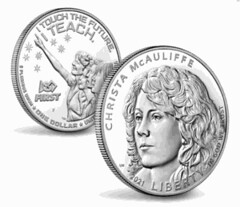 Dean Kamen is flummoxed. Flabbergasted, even.
Dean Kamen is flummoxed. Flabbergasted, even.
Typically measured in his speech and manner, the Bedford inventor and entrepreneur was recently venting his frustration and chagrin at what he sees as a missed opportunity for New Hampshire to celebrate someone who was universally admired: Concord's own Christa McAuliffe.
After years of behind-the-scenes work by Kamen and members of New Hampshire's Congressional delegation, Congress in 2019 approved a commemorative coin honoring McAuliffe, the Concord High School teacher who inspired the world and who died in the Challenger disaster on Jan. 28, 1986.
Kamen said he donated $5,000 worth of the coins to the Concord planetarium that was built in McAuliffe's honor. He'll also donate coins to the SEE Science Center he created in the Manchester Millyard.
But Kamen issued a call to action
for others to act before it's too late.
He's willing to work with any group — businesses, teacher's unions, educational associations, PTAs, civic organizations, anyone else — that wants to spearhead a campaign to promote the coins, he said. The holidays are coming up, too; wouldn't a commemorative coin be a unique gift, he asked.
To read the complete article, see:
Dean Kamen issues 'call to action' to promote coins honoring Christa McAuliffe
(https://www.unionleader.com/news/education/dean-kamen-issues-call-to-action-to-promote-coins-honoring-christa-mcauliffe/article_2f0733e9-8a69-54a4-9a14-f40b439abbaa.html)
MOTION PICTURE MONEY SEIZED IN PHILADELPHIA
Not all the fake "Motion Picture Money" is coming from China. Customs officials in Philadelphia intercepted a big shipment from Russia. -Editor
Millions of dollars worth of fake currency in U.S. dollars and euros were intercepted in Philadelphia by customs officials who say the counterfeit money arrived in the country via international air cargo from Russia.
The currency was seized on Tuesday and was destined for Chicago before Customs & Border Protection officers in Philadelphia found the money in a series of five parcels over a period of several weeks, officials said.
The most recent parcel inspected on Tuesday contained 3,011,000 euros in denominations of 10, 50, 100 and 500 euro notes. That converts to approximately $3,485,794 in U.S. dollars.
Another parcel that arrived on Sept. 14 contained $20,500 in fake $1 bills. Two days later, CBP officials seized two more parcels, one containing $2 million in fake $100 bills and the other with $15,000 in fake $1 bills. Then the day after that, authorities recovered another $990,000 in fake $100 bills.
Each of the seized shipments contained a manifest that said, "Play Money for Monopoly," and the notes were marked as prop money, officials said. Federal law regards such currency as counterfeit when it resembles real money as closely as the bills seized in these shipments. The bills may still be passed off as fictitious legal tender in the wrong hands.
These "Motion Picture" notes are the fakest-looking fakes around. Nothing impressive here. Where's the craftsmanship? -Editor
To read the complete article, see:
Customs officials in Philly seize more than $6.5 million in counterfeit currency from Russia
(https://www.phillyvoice.com/counterfeit-currency-seized-philly-russia-chicago-us-customs-euros-cbp/)
BUYS FAKE BOOZE WITH FAKE MONEY AND DIES
In the "counterfeiting karma" and "you just can't make this stuff up" departments, a Turkish man died from drinking fake alcohol bought with fake money. -Editor
 C. D. would be chalked off to the death toll from fake booze if it were not for his background. D., who passed away earlier this month in Istanbul, was identified by the police as one of the leaders of a gang churning out counterfeit money. Sabah newspaper reported that the man bought fake alcohol with the money his gang manufactured and ended up dead. Members of his gang were nabbed by Turkish security forces last week in
C. D. would be chalked off to the death toll from fake booze if it were not for his background. D., who passed away earlier this month in Istanbul, was identified by the police as one of the leaders of a gang churning out counterfeit money. Sabah newspaper reported that the man bought fake alcohol with the money his gang manufactured and ended up dead. Members of his gang were nabbed by Turkish security forces last week in Operation Benjamin,
which was held in the capital Ankara and other cities.
The gang was responsible for putting dollars, Turkish lira and other currencies in circulation and had so far produced money worth more than $562,000 (TL 5 million), according to the police. The media-savvy gang had social media accounts marketing their products (under fake names) and managed to send counterfeit bills to various cities across Turkey as well as abroad before the police cracked down on gang members. Ninety-six suspects, including gang leaders, were arrested.
Turkey has seen a series of deaths from fake drinks in the past two years. Last October, 80 people died in the span of a few weeks across the country. Also last year, 30 people in Istanbul, mostly foreign nationals, died after consuming pure alcohol, falsely believing it would help them to stave off the coronavirus. Bootleg liquor producers faced a crackdown following last year's mass deaths. Police and gendarmerie forces seized thousands of liters of counterfeit booze in raids at illegal distilleries and dozens were arrested over the deaths.
To read the complete article, see:
Man dies of fake alcohol bought with fake money in Turkey
(https://www.dailysabah.com/turkey/man-dies-of-fake-alcohol-bought-with-fake-money-in-turkey/news)
FEATURED WEB SITE: GROVE MINTING COMPANY
This week's Featured Web Site is the Grove Minting Company of Ardmore, PA.
The Grove Minting Company, founded in 2011, specializes in the production of investment metal bullion commemoratives, released annually, showcasing some of the lesser known coinage designs throughout American and European history.
Our mission defined bringing to life representations of coins which were once created as patterns but never slated for circulation. As the company has evolved, scarce and rare historic coin representations have also contributed to new creations within our product line. Rich in numismatic insight, the Grove Minting Company continues in the footsteps of tradition, utilizing artists, historians, and skilled designers to create distinct centerpieces unique to your coin collection.
All of our Grove Minting commemorative products are envisioned and manufactured in the United States of America.





